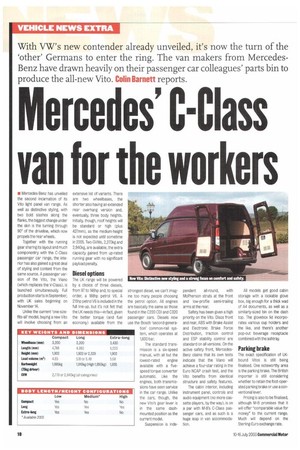Mercedes' C-Class van for the workers
Page 18

If you've noticed an error in this article please click here to report it so we can fix it.
With VW's new contender already unveiled, it's now the turn of the 'other' Germans to enter the ring. The van makers from MercedesBenz have drawn heavily on their passenger car colleagues' parts bin to produce the all-new Vito. Colin Barnett reports.
MI Mercedes-Benz has unveiled the second incarnation of its Vito light panel van range. As well as distinctive styling, with two bold slashes along the flanks, the biggest change under the skin is the turning through 90° of the driveline, which now propels the rear wheels.
Together with the running gear sharing its layout and much componentry with the C-Class passenger car range, the interior has also gained a great deal of styling and content from the same source. A passenger version of the Vito, the Viano (which replaces the V-Class), is launched simultaneously. Full production starts in September, with UK sales beginning on November 14.
Unlike the current 'one-sizefits-all' model, buying a new Vito will involve choosing from an extensive list of variants. There are two wheelbases, the shorter also having an extended rear overhang version and, eventually, three body heights. Initially, though, roof heights will be standard or high (plus 427mm), as the medium-height is not expected until sometime in 2005. Two GVWs, 2,270kg and 2,940kg, are available, the extra capacity gained from up-rated running gear with no significant payload penalty.
Diesel options
The UK range will be powered by a choice of three diesels, from 97 to 149hp and, to special order, a 188hp petrol V6. A 215hp petrol V6 is included in the full line-up, but it's not felt that the UK needs this—in fact, given the better torque (and fuel economy) available from the strongest diesel, we can't imagine too many people choosing the petrol option. All engines are basically the same as those found in the C220 CD' and C320 passenger cars. Diesels now use the Bosch 'second-generation' common-rail system, which operates at 1,600 bar.
The standard transmission is a six-speed manual, with all but the lowest-rated engine available with a fivespeed torque converter automatic. Like the engines, both transmissions have seen service in the car range. Unlike the cars, though, the new Vito's gear lever is in the same dashmounted position as the current model.
Suspension is incle
pendent all-round, with McPherson struts at the front and low-profile semi-trailing arms at the rear.
Safety has been given a high priority on the Vito. Discs front and rear, ABS with Brake Assist and Electronic Brake Force Distribution, traction control and ESP stability control are standard on all versions. On the active safety front, MercedesBenz claims that its own tests indicate that the Viano will achieve a four-star rating in the Euro NCAP crash test, and the Vito benefits from identical structure and safety features.
The cabin interior, including instrument panel, controls and audio equipment (no more cassette players, by the way), is on a par with M-B's C-Class passenger cars, and as such is a huge leap in van accommodation. All models get good cabin storage with a lockable glove box, big enough for a thick wad of A4 documents, as well as a similarly-sized bin on the dash top. The glovebox lid incorporates various cup holders and the like, and there's another pop-out beverage receptacle combined with the ashtray.
Parking brake
The exact specification of [Abound Vitos is still being finalised. One noteworthy area is the parking brake. The British importer is still considering whether to retain the foot-operated parking brake or use a conventional lever.
Pricing is also to be finalised, although M-B promises that it will offer "comparable value for money" to the current range. Much will depend on the Sterling-Euro exchange rate.




































































































































































